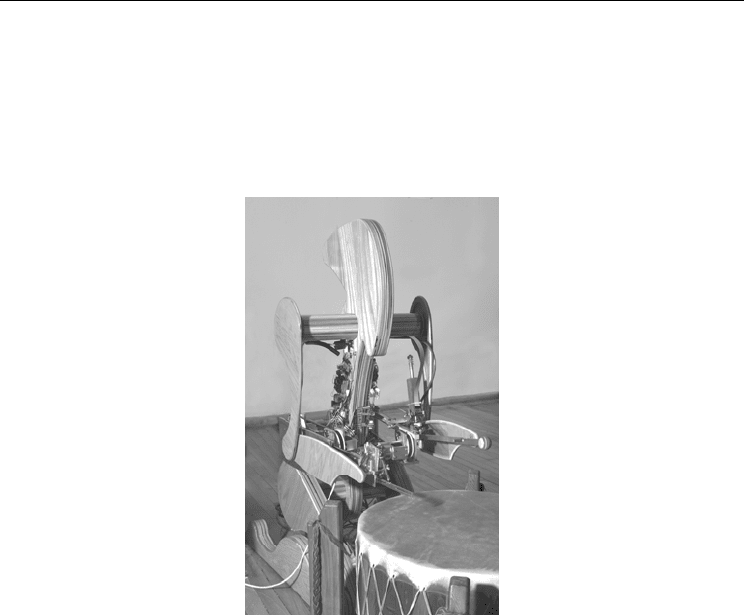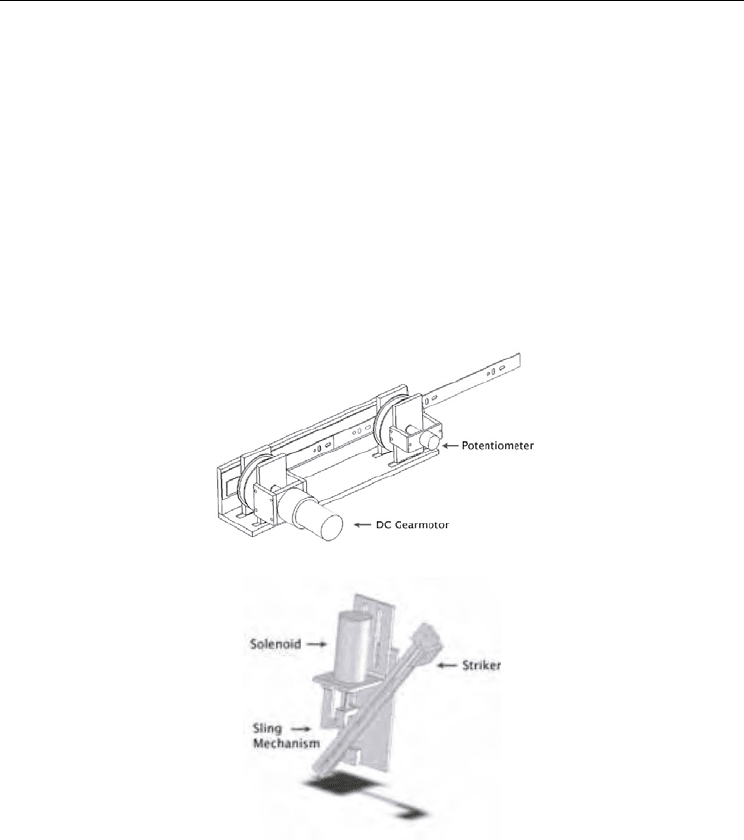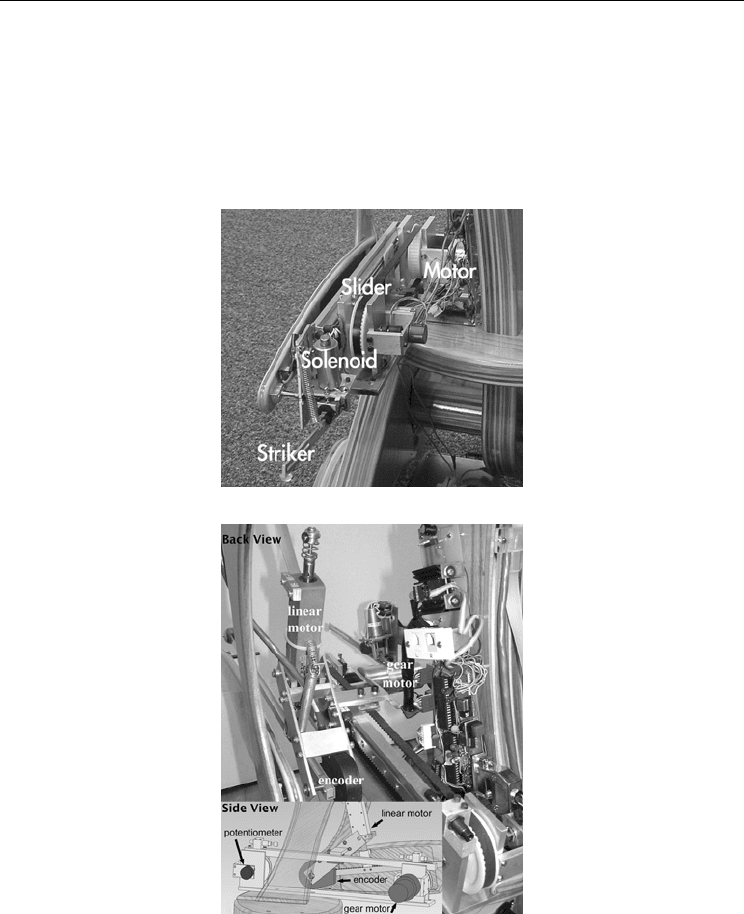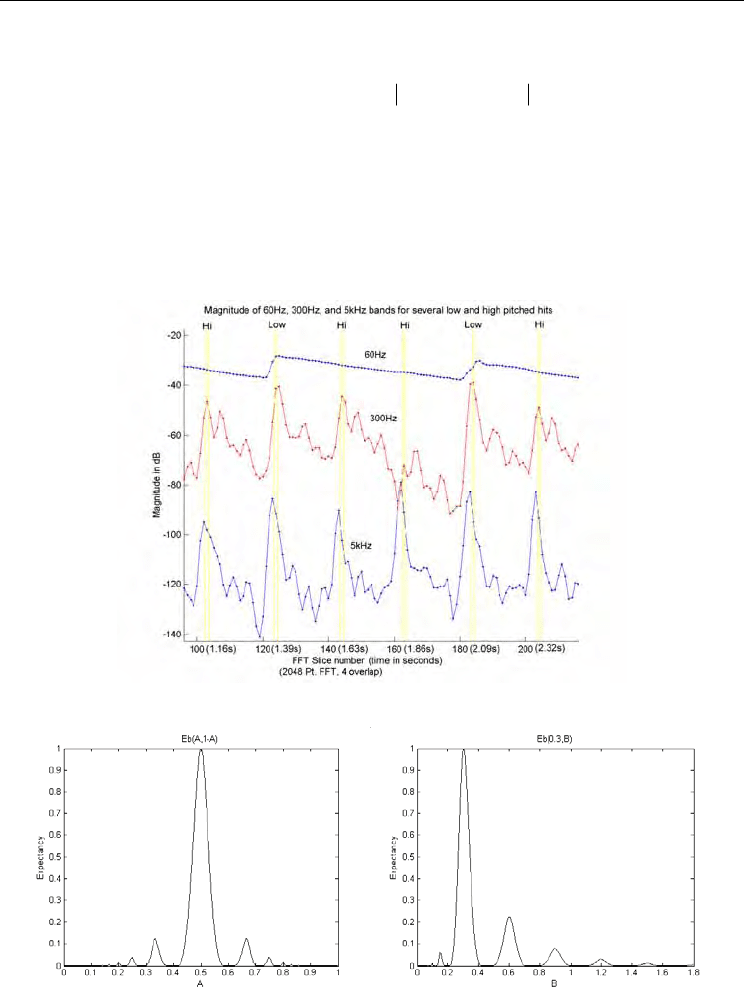Sarkar N. (ed.) Human-Robot Interaction
Подождите немного. Документ загружается.


Mixed-initiative multirobot control in USAR
421
Marble J.L., Bruemmer D.J., Few D.A. & Dudenhoeffer D.D. (2004) Evaluation of
supervisory vs. peer-peer interaction with human-robot teams. In: Proceedings of the
37th Annual Hawaii International Conference on System Sciences
Meiran N., Chorev Z. & Sapir A. (2000) Component processes in task switching. Cognitive
Psychology, 41, 211-253
Nickerson J.V. & Skiena S.S. (2005) Attention and Communication: Decision Scenarios for
Teleoperating Robots. In: Proceedings of the 38th Annual Hawaii International
Conference on System Sciences
Nielsen C.N., Goodrich M.A. & Crandall J.W. (2003) Experiments in Human-Robot Teams.
In: Proceedings of the 2002 NRL Workshop on Multi-Robot Systems
Nielsen C.W. & Goodrich M.A. (2006) Comparing the Usefulness of Video and Map
Information in Navigation Tasks. In: Proceedings of the 2006 Human-Robot Interaction
Conference, Salt Lake City, Utah
Olsen D.R. & Wood S.B. (2004) Fan-out: measuring human control of multiple robots. In:
Proceedings of the SIGCHI conference on Human factors in computing systems, pp. 231-
238. ACM Press, Vienna, Austria
Parasuraman R., Galster S., Squire P., Furukawa H. & Miller C. (2005) A Flexible Delegation-
Type Interface Enhances System Performance in Human Supervision of Multiple
Robots: Empirical Studies with RoboFlag. IEEE Systems, Man and Cybernetics-Part A,
Special Issue on Human-Robot Interactions, 33, 481-493
Parasuraman R. & Miller C.A. (2004) Trust and etiquette in high-criticality automated
systems. Communications of the ACM, 47, 51-55
Scerri P., Xu Y., Liao E., Lai G., Lewis M. & Sycara K. (2004) Coordinating large groups of
wide area search munitions. In: Recent Developments in Cooperative Control and
Optimization (eds. Grundel D, Murphey R & Pandalos P), pp. 451-480. Singapore:
World Scientific
Schurr N., Marecki J., Tambe M., Scerri P., Kasinadhuni N. & Lewis J. (2005) The Future of
Disaster Response: Humans Working with Multiagent Teams using DEFACTO. In:
Proceedings of AAAI Spring Symposium on AI Technologies for Homeland Security
Sheridan T.B. (2002) Humans and Automation: System Design and Research Issues. Human
Factors and Ergonomics Society and Wiley, Santa Monica, CA and New York.
Squire P., Trafton G. & Parasuraman R. (2003) Human control of multiple unmanned
vehicles: effects of interface type on execution and task switching times. In:
Proceedings of the 2006 Human-Robot Interaction Conference, pp. 26-32, Salt Lake City,
Utah
Trouvain B., Schlick C. & Mevert M. (2003) Comparison of a map- vs. camera-based user
interface in a multi-robot navigation task. In: Proceedings of the 2003 International
Conference on Robotics and Automation, pp. 3224-3231
Trouvain B. & Wolf H.L. (2002) Evaluation of multi-robot control and monitoring
performance. In: Proceedings of the 2002 IEEE Int. Workshop on Robot and Human
Interactive Communication, pp. 111-116
Wang J., Lewis M. & Gennari J. (2003) A game engine based simulation of the NIST urban
search and rescue arenas. In: Proceedings of the 2003 Winter Simulation Conference, pp.
1039-1045

Human-Robot Interaction
422
Wang J., Lewis M., Hughes S., Koes M. & Carpin S. (2005) Validating USARsim for use in
HRI Research. In: Proceedings of the Human Factors and Ergonomics Society 49th
Annual Meeting, pp. 457-461
Woods D.D., Tittle J., Feil M. & Roesler A. (2004) Envisioning human-robot coordination in
future operations. IEEE Transactions on Systems, Man & Cybernetics, 34, 210-218
Yanco H.A., Drury J.L. & Scholtz J. (2004) Beyond Usability Evaluation: Analysis of Human-
Robot Interaction at a Major Robotics Competition. Journal of Human-Computer
Interaction, 19, 117-149
24
Robotic Musicianship – Musical Interactions
Between Humans and Machines
Gil Weinberg
Georgia Institute of Technology
USA
1. Introduction
The Robotic Musicianship project aims to facilitate meaningful musical interactions
between humans and machines, leading to novel musical experiences and outcomes. The
project combines computational modelling of music perception, interaction, and
improvisation, with the capacity to produce acoustic responses in physical and visual
manners. The motivation for this work is based on the hypothesis that real-time
collaboration between human and robotic players can capitalize on the combination of
their unique strengths to produce new and compelling music. Our goal is to combine
human qualities such musical expression and emotions with robotic traits such as
powerful processing, the ability to perform sophisticated mathematical transformations,
robust long-term memory, and the capacity to play accurately without practice. A similar
musical interaction can be achieved with software applications that do not involve
mechanical operations. However, software-based interactive music systems are hampered
by their inanimate nature, which does not provide players and audiences with physical
and visual cues that are essential for creating expressive musical interactions. For
example, motion size often corresponds to loudness and gesture location often relates to
pitch. These cues provide visual feedback, help performers anticipate and coordinate their
playing, and create an engaging musical experience by providing a visual connection to
the generated sound. Software based interactive music systems are also limited by the
electronic reproduction and amplification of sound through speakers, which cannot fully
capture the richness of acoustic sound. Unlike these systems, the anthropomorphic
musical robot we developed, named Haile, is designed to create acoustically rich
interactions with humans. The acoustic richness is achieved due to the complexities of real
life systems, as opposed to digital audio nuances that require intricate design and that are
limited by the fidelity and orientation of speakers. In order to create intuitive as well as
inspiring social collaboration with humans, Haile is designed to analyze music based on
computational models of human perception and to generate algorithmic responses that
are unlikely to be played by humans (“listen like a human, improvise like a machine”). It
is designed to serve as a test-bed for novel forms of musical human-machine interactions,
bringing perceptual aspects of computer music into the physical world both visually and
acoustically. We believe that this approach can lead to new musical experiences, and to
new music, which cannot be conceived by traditional means.

Human-Robot Interaction 424
2. Related Work
Two main research areas inform our effort to develop robotic musicianship – musical
robotics, which focuses on the construction of automated mechanical sound generators and
machine musicianship, which centres on computer models of music theory, composition,
perception, and interaction. Early work on musical robotics focused on mechanical keyboard
instruments such as the Pianista by French inventor Fourneax (see a comprehensive historic
review of musical robots in (Kapur 2005)). In recent years, the field has received commercial,
artistic, and academic interest, expanding to anthropomorphic designs as well as robotic
musical instruments, including chordophones, aerophones, membranophones and
idiophones. Several approaches have been recently explored for robotic stringed
instruments. GuitarBot (Singer et al. 2004) , for example, is a mechanical guitar operated by
a set of DC servomotors driving a belt with multiple picks playing four strings. The pick
position, controlled by a photosensor and a “clapper” solenoid, is used as a damper. Jordà’s
Electric Guitar Robot (Jordà 2002), on the other hand, has six strings, that can be plucked by
twelve picks, driven by an electro-valve hammer-finger. Current approaches for mechanical
guitars, however, are not designed to explore the full range of sonic variety through string
techniques such as bouncing, bowing, strumming, scratching, or rubbing. Other attempts
have been made to develop expressive wind instrument robots. The Anthropomorphic Flute
Robot (Chida, Okuma et al. 2004), uses a complex mechanical imitation of human organs in
an effort to accurately reproduce human flute playing. The elaborate apparatus includes
robotic lungs, neck, lips, fingers, and tongue. Other examples for aerophone robotic
instruments are Toyota’s Robotic Trumpeter (Toyota 2007) and the Rae’s Autosax (Rae
2005), which are programmed to follow deterministic rules. More varied work has been
done on robotic percussionists, both for idiophone and membranophone instruments. The
ModBots (Singer et al. 2004), for example, are miniature modular instruments designed to
affix to virtually any structure. Each ModBot consists of only one electromechanical actuator
(a rotary motor or a linear solenoid), which responds to varying degrees of supply voltage
regulated by a microcontroller. A more elaborated mechanism by Singer is utilized in the
TibetBots, which consist of six robotic arms that strike three Tibetan singing bowls. Here, an
effort was made to capture a wider timbral variety by using two robotic arms (controlled by
solenoids) for each bowl to produce a richer set of sounds. Another approach for broadening
timbre and pitch versatility is taken by the Thelxiepeia (Baginsky 2004). The instrument
consists of a mechanical drumstick and a motorized mechanism to rotate the drum
circumference, which can lead to the production of a range of pitches. Other robotic
instruments which influenced our work were developed by Trimpin (Trimpin 2000), Rae
(Rae 2005), and Van Doressen (Dorssen 2006).
The second research area that informs our work is machine musicianship. Here, researchers
design and develop computer systems that analyze, perform, and compose music based on
theoretical foundations in fields such as music theory, computer music, cognition, artificial
intelligence and human-computer-interaction (Rowe 1992). One of the earliest research
directions in this field is the “Score Follower”, in which the computer tracks a live soloist
and synchronizes MIDI (Dannenberg 1984) (Vercoe 1984), and recently audio (Orio,
Lemouton et al. 2003), accompaniment to the musical input. The classic score following
approach focuses on matching predetermined musical events to real-time input. A more
improvisatory approach is taken by systems such as Voyager (Lewis 2000) and Cypher
(Rowe 1992). Here the software analyzes musical input in real time and generates musical

Robotic Musicianship – Musical Interactions Between Humans and Machines 425
responses by manipulating a variety of parameters such as melody, harmony, rhythm,
timbre, and orchestration. David Cope has taken a non-real time approach in his system for
analyzing composers’ styles based on MIDI renditions of their compositions (Cope 1996).
Cope’s algorithm learns the style of a given composer by modelling aspects such as
expectation, memory, and musical intent. It can then generate new compositions with
stylistic similarities to the originals. The “Continuator” system, on the other hand, takes a
real-time approach for learning the improvisation style of musicians as they play
polyphonic MIDI instruments (Pachet 2003). The application uses Hidden Markov Models
to learn and analyze the input and continues the improvisation in the style of the human
performer.
Particularly note-worthy research field in machine musicianship is computational modelling
of music perception in which, researches develop cognitive and computational models of low-
and high-level musical percepts. Lower level cognitive modelling address percepts from note
onset detection to pitch and beat detection, using audio sources (Puckette 1998) (Scheirer 1998)
(Foote and Uchihashi 2001) as well as MIDI (Winkler 2001). Higher-level rhythmic percepts
include more subjective concepts such as rhythmic stability, melodic similarity and attraction.
Desain and Honing’s model of rhythmic stability is based on the relationship between pairs of
adjacent note durations (Desain and Honing 2002); Tanguiane counts the number of coincident
onset in an effort to model rhythmic similarity of different audio signals (Tanguiane 1993);
Smith utilizes dynamic time warping techniques to retrieve similar melodies from a folk song
database (Smith et al. 1998); and Lerdahl and Jackendoff calculate the melodic attraction
between pitches in a given tonality based on a table of anchoring strengths (Lerdahl &
Jackendoff 1983). Informed by such approaches for perceptual modelling, our robot is
designed to respond with algorithmically generated musical outcomes using a novel approach
for computational composition and improvisation. This aspect of the system is based on
theoretical approaches for musical improvisation and interaction (Pressing 1994), (Johnson-
Laird 2002), as well as practical efforts using methods such as genetic algorithms. GenJam, for
example, is an interactive computer system that improvises over a set of jazz tunes using an
initial phrase population that is generated stochastically (Biles 1994). GenJam’s fitness function
is based on human input, where in every generation the user determines which phrases
remain in the population. Other systems use methods such as real-time fitness criteria (Moroni
2000) or human feedback for training a neural network-based fitness function (Tokui & Iba
2000). In the second phase of the robotic musicianship project we developed an improvisatory
genetic algorithm that combines human aesthetics and perception with algorithmic “gene
mixing” improvisation.
3. Research questions
A number of research questions guide our effort to create intuitive and inspiring musical
human-robot interactions and to establish the concept of robotic musicianship:
• Can we effectively implement computational schemes that model how humans
represent and process rhythmic, melodic, and harmonic structures in music? Can a
robot use such models to infer high-level musical meaning from live musical input and
respond in a musically intuitive manner?
• Can algorithmic models of musical improvisation create meaningful and inspiring
musical responses? Can such algorithmic responses lead to novel socio-musical human-
machine interaction and to music that cannot be created by humans?

Human-Robot Interaction 426
• What is the role of physical, visual, and acoustic cues in multi-player musical interactions?
Can a robot utilize physical properties to enrich musical interactions with humans?
Below we describe our efforts to address these research questions through physical and
mechanical design (section 4), rhythmic and melodic applications (sections 5), user studies
(section 6), and a number of directions for future work (section 7).
4. Physical and Mechanical Design
Figure 1. Haile’s design
In order to support familiar and expressive interactions with human players, Haile’s design
is anthropomorphic, utilizing two percussive arms that can move to different locations and
strike with varying velocities. The first prototype was designed to play a Native American
Pow Wow drum – a unique multi player instrument that supports the collaborative nature
of the project. For pitch-oriented applications, the robot was later adjusted to play a one-
octave xylophone. In order to match the aesthetics of these musical instruments, we chose to
construct the robot from wood. The wooden parts were made using a CnC wood cutting
machine and constructed from several layers of plywood glued together. Metal joints were
designed to allow shoulder and elbow movement as well as leg adjustability for different
instrument heights. While attempting to create an organic look for the robot, it was also
important that the technology was not completely hidden, so that co-players could see and
understand the robot’s operation. We therefore left the mechanical apparatuses uncovered
and embedded a number of LEDs on Haile’s body, providing an additional representation
of the mechanical actions (See Figure 1).
Haile controls two robotic arms; the right arm is designed to play fast notes, while the left
arm is designed to produce larger and more visible motions that produce louder sounds.
Both arms can adjust the strikes sound in two manners: different pitches are achieved by
striking the instruments in different locations, and volume is adjusted by hitting with
varying velocities. To move to different vertical positions, each arm employs a linear slide, a

Robotic Musicianship – Musical Interactions Between Humans and Machines 427
belt, a pulley system, and a potentiometer to provide feedback (see Figure 2). Unlike robotic
drumming systems that allow hits at only a few discrete locations, Haile’s arms move
continuously over a distance of 10 inches (movement timing is 250 ms. from end to end).
The right arm’s striking mechanism is loosely based on a piano hammer action and consists
of a solenoid driven device and a return spring (see Figure 3). The arm strikes at a maximum
speed of 15 Hz, faster than the left arm’s maximum speed of 11 Hz. However, the right arm
cannot generate a wide dynamic range or provide easily noticeable visual cues, which limits
Haile’s expression and interaction potential. The left arm was designed to address these
shortcomings, using larger visual movements, and a more powerful and sophisticated
hitting mechanism. Whereas the striking component of the right arm is about the size of a
finger and can only move 2.5 inches vertically (see figure 4), the entire left forearm takes
part in the striking motion and can move up and down eight inches. A linear motor and an
encoder located at the left elbow are used to provide sufficient force and control for the
larger mass and motions (see Figure 5).
Figure 2. The right arm slider mechanisms
Figure 3. The right arm striking mechanism
Max/MSP, a graphical programming environment (Cycling74 2007), was used for high-level
musical programming in an effort to make the project accessible to composers, performers,
and students. The first right arm prototype incorporated the USB based Teleo System
(MakingThings 2005) as the main interface between Max/MSP and Haile’s sensors and
motors. Low-level control of the solenoid-based right arm’s position was computed within
Max/MSP, which required a continuous feed of position updates to the computer. This
consumed much of the communication bandwidth as well as processor time on the main
computer. The final two-arm mechanism utilizes multiple onboard microprocessors for local
low-level control as well as Ethernet communication with the main computer. The new

Human-Robot Interaction 428
system, therefore, facilitates faster and more sophisticated control (2ms control loop) and
requires only low bandwidth communications with the operating computer. Each arm is
locally controlled by an 18F452 PIC microprocessor, both of which receive RS232
communications from a Modtronix Ethernet board (SBC68EC). The Ethernet board receives
3 byte packets from the computer, a control byte and two data bytes. The protocol utilizes an
address bit in the control byte to send the information to the appropriate arm processor. The
two data bytes typically contain position and velocity set points for each hit, but can also be
used to update the control parameters.
Figure 4. Haile’s right arm design
Figure 5. Haile’s left arm design
Two onboard PIC microprocessors are responsible for controlling the arms’ sliding and
hitting mechanisms, ensuring that the impacts occur at the requested position and velocity.
In order to allow enough time for the arms to move to the correct location and execute the
strokes, a 300 ms. delay line is implemented between signal reception and impact. It has
been shown that rhythmic errors of only 5 ms are detectable by average listeners (Coren, et al,

Robotic Musicianship – Musical Interactions Between Humans and Machines 429
2003), therefore, it was important to ensure that this delay remained accurate and constant
regardless of different hit velocities, allowing to easily compensate for it in the higher-level
interaction application. Both arms store incoming hit commands in a First-In-First-Out queue,
moving towards the location of a new note immediately after each hit. Due to its short vertical
hitting range, the solenoid driven right arm allows for fairly consistent stroke time. We,
therefore, implemented the 300 ms delay as a constant for this arm. The left arm, on the other
hand, undergoes much larger movements, which requires complex feedback control to ensure
that impact occurs at the right time, regardless of hits velocity. While waiting for incoming
notes, the left arm remains about one inch above the surface of the instrument. When a new
note is received, the arm is raised to a height proportional to the loudness of the hit. After a
delay determined by the desired velocity and elevation, the arm descends towards the
instrument under velocity control. After impact, the arm returns back to its standby position
above the instrument. Extremely fast notes utilize a slightly different control mode that makes
use of the bounce of the arm in preparation for the next hit. This mechanism allows the left
arm to control a wide dynamic range and provides performers and viewers with anticipatory
and real-time visual cues, enhancing expression and enriching the interaction representation.
5. Applications
5.1 Phase one – Rhythmic Interaction
The first phase of the project aimed at facilitating rhythmic collaboration between human
drummers and Haile, addressing aspects such as rhythmic perception, improvisation, and
interaction. In perception, we developed models for low- and high-level rhythmic percepts,
from hit onset, amplitude, and pitch detection, through beat and density analysis, to rhythmic
stability and similarity perception. For hit onset and amplitude detection we adjusted the
Max/MSP bonk~ object (Puckette 1998) to address the unique character of the Pow Wow
drum- a multi player Native American percussion instrument, which was chosen for the
project due to its collaborative nature. Bonk~ provides effective onset attack detection but its
frequency bands analysis is insufficient for accurate pitch detection due to the Pow Wow
drum’s low frequency and long reverberating sounds. Since bonk~ is hard-coded with a 256
point analysis window, the lowest frequency it can analyze is 172Hz – too high for the Pow
Wow drum which has a natural frequency of about 60 Hz. Moreover, onset detection is
complicated when high frequency hits are masked by the long decay of the previous low
strikes (see Figure 6). To address these issues, we wrote a Max/MSP external object that used
2048 points FFT to determine both the magnitude of lower frequency bins and the change in
those magnitudes between successive analysis frames. By taking into account the spectral
changes in addition to the magnitudes, Haile could better determine whether energy in a
particular frequency band came from a current hit or from previous ones (See Figure 6).
Other relatively low-level perceptual modules that were developed were beat detection,
where domain detection was followed by autocorrelation of tempo and phase (Davies and
Plumbley 2005) and density detection, where we looked at the number of note onsets per
time unit to represent the density of the rhythmic structure. We also implement a number of
higher-level rhythmic analysis modules for percepts such as rhythmic stability, based on
(Desain and Honing 2002), and similarity based on (Tanguiane 1993). The stability model
calculates the relationship between pairs of adjacent note durations, rated according to their
perceptual expectancy based on three main criteria: perfect integer relationships are favoured,

Human-Robot Interaction 430
ratios have inherent expectancies (i.e., 1:2 is favoured to 1:3 and 3:1 is favoured to 1:3), and
durations of 0.6 seconds are preferred. The expectancy function can be computed as:
()() ()()
()
drr
rrrrBAE
d
r
p
b
round
5.0floor2round),(
0
×
−−×−=
³
where A and B are the durations of the two neighbouring notes,
r = max A /B,B / A
()
represents the (near) integer relationship between note durations, p controls the shape of the
peaks, and d is negative and affects the decay rate as the ratios increases. This function is
symmetric around r=1 when the total duration is fixed (see Figure 7a). Generally, the
expectancy function favours small near-integer ratios and becomes asymmetric when the
total duration varies, exhibiting the bias toward the 600 ms. interval (see Figure 7b).
Figure 6. Magnitude plots from a 60Hz, 300Hz, and 5kHz frequency band over several low
and high-pitched hits showing the relatively slow decay of the low-pitched hits
(a) (b)
Figure 7. Basic expectancy of intervals A and 1-A (a) and 0.3 and B (b), reproduced from
(Desain and Honing 2002)
